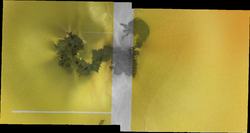
Prometheus (volcano)
Encyclopedia

Volcano
2. Bedrock3. Conduit 4. Base5. Sill6. Dike7. Layers of ash emitted by the volcano8. Flank| 9. Layers of lava emitted by the volcano10. Throat11. Parasitic cone12. Lava flow13. Vent14. Crater15...
on Jupiter's
Jupiter
Jupiter is the fifth planet from the Sun and the largest planet within the Solar System. It is a gas giant with mass one-thousandth that of the Sun but is two and a half times the mass of all the other planets in our Solar System combined. Jupiter is classified as a gas giant along with Saturn,...
moon
Natural satellite
A natural satellite or moon is a celestial body that orbits a planet or smaller body, which is called its primary. The two terms are used synonymously for non-artificial satellites of planets, of dwarf planets, and of minor planets....
Io
Io (moon)
Io ) is the innermost of the four Galilean moons of the planet Jupiter and, with a diameter of , the fourth-largest moon in the Solar System. It was named after the mythological character of Io, a priestess of Hera who became one of the lovers of Zeus....
. It is located on Io's hemisphere facing away from Jupiter at 1.52°S 153.94°W. Prometheus consists of a 28 kilometres (17.4 mi)-wide volcanic pit named Prometheus Patera and a 100 kilometres (62.1 mi)-long compound lava flow, all surrounded by reddish sulfur
Sulfur
Sulfur or sulphur is the chemical element with atomic number 16. In the periodic table it is represented by the symbol S. It is an abundant, multivalent non-metal. Under normal conditions, sulfur atoms form cyclic octatomic molecules with chemical formula S8. Elemental sulfur is a bright yellow...
and circular, bright sulfur dioxide
Sulfur dioxide
Sulfur dioxide is the chemical compound with the formula . It is released by volcanoes and in various industrial processes. Since coal and petroleum often contain sulfur compounds, their combustion generates sulfur dioxide unless the sulfur compounds are removed before burning the fuel...
volcanic plume deposits. The volcano was first observed in images acquired by the Voyager 1
Voyager 1
The Voyager 1 spacecraft is a 722-kilogram space probe launched by NASA in 1977, to study the outer Solar System and eventually interstellar space. Operating for as of today , the spacecraft receives routine commands and transmits data back to the Deep Space Network. At a distance of as of...
spacecraft in March 1979. Later that year, the International Astronomical Union
International Astronomical Union
The International Astronomical Union IAU is a collection of professional astronomers, at the Ph.D. level and beyond, active in professional research and education in astronomy...
named this feature after a Greek
Greek mythology
Greek mythology is the body of myths and legends belonging to the ancient Greeks, concerning their gods and heroes, the nature of the world, and the origins and significance of their own cult and ritual practices. They were a part of religion in ancient Greece...
fire god, Prometheus
Prometheus
In Greek mythology, Prometheus is a Titan, the son of Iapetus and Themis, and brother to Atlas, Epimetheus and Menoetius. He was a champion of mankind, known for his wily intelligence, who stole fire from Zeus and gave it to mortals...
.
Prometheus is the site of a volcanic eruption that has been ongoing since at least the Voyager 1 encounter in 1979. Between the Voyager encounters and the first observations by Galileo, a 6700 square kilometres (2,586.9 sq mi) flow field was emplaced. Later Galileo observations of this flow field revealed numerous small breakouts, particularly on the western end of the flow field.
Prometheus is the site of two volcanic eruption plumes: a small, sulfur-rich plume erupting from the magma-source vent at the eastern end of the flow field and a 75 kilometre-tall, -rich dust plume erupting from the active flow front at the other end. The former forms a diffuse, red deposit to the east of the Prometheus flow field. The latter forms a bright, circular deposit surrounding the entire volcano and lava flow. The -rich plume is generated as lava at the western end of the flow field covers sulfur dioxide frost, heating and vaporizing it. This is accomplished at multiple breakouts, generating gas and dust for the visible dust plume. Prometheus' plume has been observed by both Voyager spacecraft, Galileo, and New Horizons, at every appropriate imaging opportunity.

